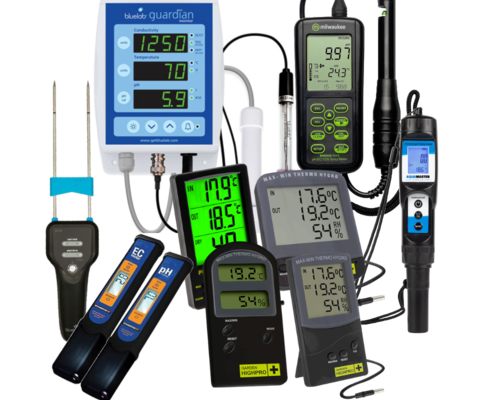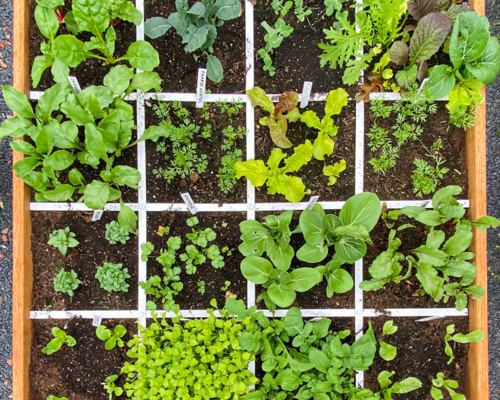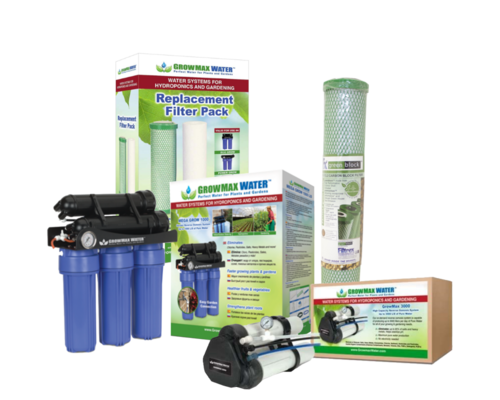Growing plants is a complex and delicate art, with numerous factors affecting crop health and growth. To ensure that crops grow healthily, it is essential to carefully measure and monitor environmental factors such as temperature, humidity, pH and EC levels. By measuring these values regularly and adjusting them as needed, growers can create the optimal conditions for the growth and development of their crop. In this blog, we will discuss different measurement tools used in plant cultivation, and the importance of accurately measuring these values.
What is a pH meter?
A pH meter is a device used to measure the acidity or alkalinity of a solution. It measures the concentration of hydrogen ions (H+) in a solution and translates it into a pH value, which ranges from 0 to 14. A pH value of 7 is considered neutral, a pH value lower than 7 is acidic and a pH value higher than 7 is alkaline.
Why is pH important in plant cultivation?
pH is an important factor in plant cultivation because it affects the availability of nutrients to the crop. Plants need specific pH levels to absorb nutrients. An improper pH level can lead to a nutrient deficiency or excess, causing plants to fail to grow and develop properly.
Most crops need a pH between 6.0 and 7.0. However, some crops need a specific pH level to grow optimally. For example, potatoes and strawberries need a pH between 5.0 and 5.5, while broccoli and lettuce need a pH between 6.0 and 6.5.
How do you use a pH meter?
A pH meter is easy to use. All you need is a sample of the solution you want to test and a pH meter. Most pH meters come with instructions for use, but below are the basic steps for using a pH meter:
- Calibrate the pH meter. This means setting the meter to the correct pH value so that it can measure accurately.
- Fill the sample holder of the pH meter with the solution you want to test.
- Insert the electrode of the pH meter into the solution.
- Wait for the pH value to appear on the screen. Most pH meters display the pH value within a few seconds.
- Write down the pH value and, if necessary, repeat the measurement for more accurate results.
What is an EC meter?
An EC meter is a device used to measure the electrical conductivity of a solution. Electrical conductivity is a measure of the amount of dissolved ions in a solution. The more dissolved ions there are, the higher the electrical conductivity is. EC stands for electrical conductivity.
Why is EC value important in plant cultivation?
EC value is important in growing crops because it reflects the concentration of dissolved nutrients in a solution. Crops need specific EC values to absorb and grow enough nutrients. An incorrect EC value can lead to a nutrient deficiency or excess, preventing the crop from growing and developing properly.
How do you use an EC meter?
An EC meter is easy to use. All you need is a sample of the solution you want to test and an EC meter. Below are the basic steps for using an EC meter:
- Calibrate the EC meter. This means setting the meter to the correct EC value so that it can measure accurately.
- Fill the sample holder of the EC meter with the solution you want to test.
- Insert the electrode of the EC meter into the solution.
- Wait for the EC value to appear on the screen. Most EC meters display the EC value within a few seconds.
- Write down the EC value and, if necessary, repeat the measurement for more accurate results.
What is a combo meter?
A combo meter is a device used to measure both the pH and EC levels of a solution. It is a very useful tool for growers because it allows them to measure both values simultaneously with just one device. Combo meters are often used in plant cultivation to measure the pH and EC values of nutrient solutions.
Why is a combo meter important in plant cultivation?
The pH and EC levels are both important in plant cultivation because they reflect the nutritional status of the plants. An incorrect pH value can lead to improper nutrient uptake by the plants, while an incorrect EC value can lead to nutrient deficiency or abundance. Using a combo meter allows growers to measure both values simultaneously, allowing them to better match their nutrient solutions to the needs of their crop.
How do you use a combo meter?
A combo meter is easy to use. Below are the basic steps for using a combo meter:
- Calibrate the combo meter. This means setting the meter to the correct pH and EC levels so that it can measure accurately.
- Fill the sample holder of the combo meter with the solution you want to test.
- Insert the electrodes of the combo meter into the solution.
- Wait for the pH and EC values to appear on the screen. Most combo meters display both values within a few seconds.
- Write down the pH and EC values and repeat the measurement if necessary for more accurate results.
What is a thermometer?
A thermometer is a measuring instrument used to measure the temperature of your growing room or other environment. In plant cultivation, a thermometer is often used to measure the temperature of the soil, water or air.
Why is a thermometer important in plant cultivation?
Temperature is an important factor in plant cultivation because it affects crop growth and development. Each plant has its own optimal temperature range, and if the temperature is too high or too low, it can hinder or even kill plant growth and development. Therefore, it is important to carefully monitor the temperature in plant cultivation and adjust if necessary.
How do you use a thermometer in plant cultivation?
A thermometer is easy to use. Below are the basic steps for using a thermometer:
- Choose the right thermometer for the situation. There are different types of thermometers available. Make sure you choose the right thermometer for the situation you want to use it in.
- Place the thermometer in the right location. Depending on what you want to measure, you can place the thermometer in the soil, water or air. Make sure the thermometer is placed in a representative location where the temperature can be measured properly.
- Wait for the thermometer to measure the temperature. Most thermometers display the temperature within a few seconds.
- Write down the temperature and, if necessary, repeat the measurement for more accurate results.
What is a hygrometer?
A hygrometer is a measuring instrument used to measure humidity. In plant cultivation, a hygrometer is often used to measure the humidity in the greenhouse, greenhouse or other growing space.
Why is a hygrometer important in plant cultivation?
Humidity is an important factor in plant cultivation because it affects crop growth and development. If the humidity is too high or too low, it can hinder plant growth and development. Therefore, it is important to properly monitor the humidity in plant cultivation and adjust if necessary.
Do you want more information?
Want more information on a specific topic? Check our "Knowledge Center" blog page to see if the information you need is among them. Is the information not in one of our blogs? We have a piece of text with each category where the products are explained in broad terms. The most popular categories are:



